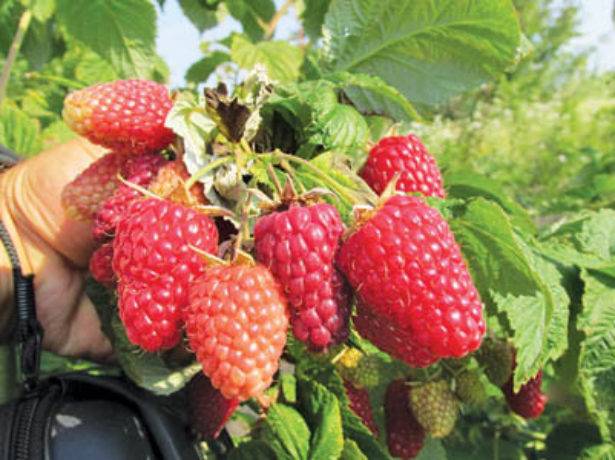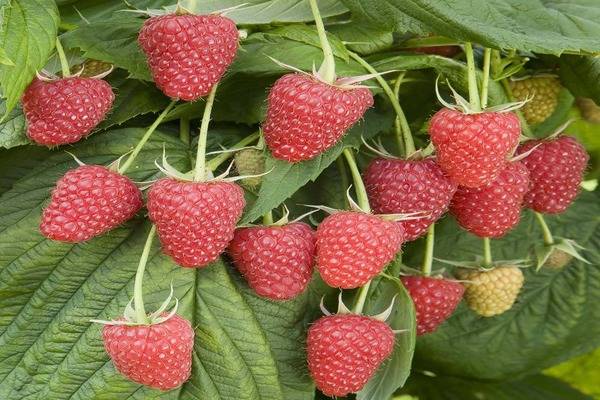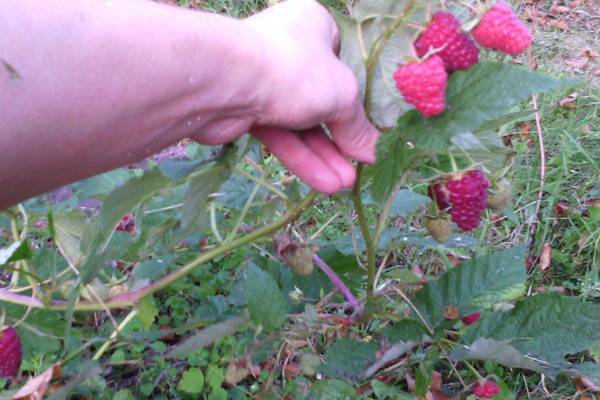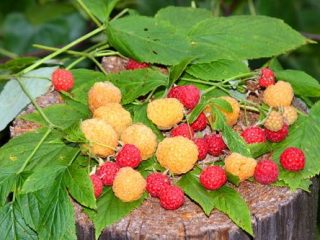Content
Large-fruited raspberry varieties leave almost no one indifferent. The elegant berries of the remontant raspberry Nizhegorodets stand out for their size in the line of large-fruited varieties.
Description of the variety
The bushes differ in average height (1.5-1.8 m), with slightly drooping shoots. One plant gives no more than 7-8 shoots. Stems are annual, characterized by light green color, do not have pubescence. In the second year, the stems turn light brown and take on a purple hue. Sharp and stiff thorns grow green at the base, light red at the ends. In the Nizhegorodets variety, thorns grow along the entire length of the stems, moreover, at the base they are located more often, and closer to the apex, the number of thorns decreases. Leaves are weak in size, serrated medium-sharp edges.
The dark red berries of the Nizhegorodets variety attract with their appearance (as in the photo). The average weight of the berries is 5-6 g, but there are also large ones - about 12 g. The shape of the berries is conical (some summer residents describe it as rounded-conical). The structure of the berries is dense, dry, the taste is sweet with a slight sourness and a characteristic raspberry aroma. Nizhegorodets begins to bear fruit in the last days of July and ends in late autumn.
Advantages of the raspberry variety Nizhegorodets:
- berries of large shapes, excellent appearance, excellent density. The ripe crop weighs on the bushes for a long time, without crumbling (practically up to two weeks). This quality is of particular importance for summer residents who come only for the weekend;
- raspberries of the Nizhegorodets variety perfectly tolerate transportation - the berries do not flow, do not crumple and retain their shape well;
- the harvest ripens at the same time, and the berries stand out with uniform coloration and are tied along the entire length of the shoot;
- the Nizhegorodets variety can be called unpretentious. In the conditions of Central Russia, the variety shows drought resistance and tolerates high temperatures well. Due to their high density, berries are not baked in the sun. Frost resistance is also quite high. Some gardeners have observed isolated cases of freezing of bushes (in the northern zones);
- since the roots of raspberries are fibrous, the variety Nizhegorodets gives a small amount of growth. Therefore, you should not be afraid that raspberries will creep around the country;
- despite the abundance of thorns, there are no problems with harvesting or caring for plantings.
Some disadvantages of the Nizhegorodets raspberry variety should not be missed:
- oblique shoots under the weight of ripe berries strongly lean to the ground. Therefore, it is necessary to monitor the bushes and tie up the stems in a timely manner;
- many summer residents state that the crop acquires tasty sweetness only when it is fully ripe and in good weather. Therefore, in the cool season, the berries can maintain a high level of acidity.
The raspberry variety Nizhegorodets demonstrates high resistance to fungal attack. diseases and a raspberry mite.
Planting seedlings
Raspberry Nizhegorodets bears excellent fruit on light, nutritious, moderately moist soils. The culture is very demanding on lighting.
Spring planting
A plot for raspberries of the Nizhegorodets variety begins to be prepared in the fall. The soil is thoroughly cleaned of weeds and dug deeply.At this stage, the soil should be well fertilized: 2-3 buckets of peat are applied per square meter of area, one glass of superphosphate and potassium sulfate (or 200-300 g of complex inorganic fertilizers) each.
In the spring (second half of April), holes are dug on the site with a size of 40x40 cm, a depth of 40-50 cm. Particular attention is paid to the inspection and preparation of raspberry seedlings Nizhegorodets:
- the root system of the shoots must be well developed, the trunk must be free of damage and signs of disease;
- seedlings should be 30-40 cm long, with a stem thickness at the base of about 0.7-1 cm.
Seedlings of the remontant raspberry variety Nizhegorodets are lowered into moistened holes, carefully straightened the root system and covered with earth. In this case, it is necessary to ensure that the root collar is not covered with soil and is flush with the soil surface. Shoots are carefully cut at a height of about 20 cm, watered with water. The land around is slightly loosened and mulched.
Planting seedlings in autumn
With this method, it is recommended to start preparing the soil in the spring. Green manures (mustard, rye, lupine) are sown in the designated area. About a month and a half before planting seedlings of the Nizhegorodets variety, green manure crops are dug up together with the ground. The rest of the planting stages coincide with the spring option.
In order for the raspberry seedlings to take root and take root in Nizhegorodets, it is necessary to start arranging the raspberry plant a month before the first frost. A more accurate period is determined by the climatic characteristics of the regions. In the southern regions, time is allocated for this in mid-September-early October. In central Russia and in the Moscow region, seedlings of the Nizhegorodets variety can be planted in early September.
Culture care
Raspberry bushes of the Nizhegorodets variety grow quite tall and spreading, therefore trellis must be equipped along the rows. For this, supports are driven in every three meters, on which 2-3 rows of wire are imposed (at the level of 0.5 m, 1 m, 1.5 m from ground level).
Watering raspberries once a week is enough. Naturally, in dry times, the frequency of watering increases. Moreover, it is necessary to ensure that the soil is soaked to a depth of about 30-40 cm. Most of all, the watering process is paid attention to before the flowering of the culture, as well as during the period of setting and ripening of the berries of the Nizhegorodets variety.
The most optimal way to water raspberries of the Nizhegorodets variety is to arrange a drip system. At the same time, it is possible to moisten the soil directly around the stems. This saves water and allows you to evenly saturate the soil with liquid. It is advisable to use soil mulching - the frequency of watering is noticeably reduced, the soil retains moisture longer.
Fertilization
If, on the eve of planting seedlings, the soil was fertilized with high quality, then for two years you can not worry about the fertility of the soil. But already from the third year, it is necessary to apply fertilizers annually.
The most active raspberry Nizhegorodets responds to the use of organic feeding. It is recommended to use a mullein solution (a liter of rotted manure is taken for 10 liters of water). Add organic matter 2-3 times during the growing season at the rate of 3-5 liters of solution per square meter of area.
When growing remontant raspberries of the Nizhegorodets variety, it is important to use mineral fertilizers. When planting, it is enough to use superphosphate. And already potash mixtures that do not contain chlorine are recommended to be added regularly. The best option is nitroammophoska (40-100 g is enough for a square meter of soil).
Raspberry pruning
In the spring, the raspberries of the Nizhegorodets variety are cleaned for sanitary purposes - dry, damaged stems are removed. In order not to be mistaken with the choice, you must wait for the time when buds swell on the shoots of the remontant raspberry. In this case, it is easier to isolate healthy and diseased plants.
Even experienced gardeners call Nizhegorodets raspberries super raspberries. When creating the right conditions for growth, the variety will delight with surprisingly tasty and large fruits.












